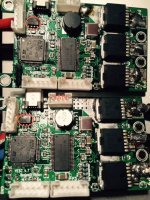erwincoumans
100 W
- Joined
- Apr 2, 2015
- Messages
- 141
It is possible to damage a VESC when connecting to another VESC over can bus
(to share single servo PPM signal). This happened to me already with 4 VESC's,
soldered by 2 different people. Once damaged, some part of the VESC becomes really hot,
as if the voltage regulator doesn't work anymore. You will have to trouble-shoot and replace parts to make the VESC work again.
Only two wires of the can bus are connected: CAN Hi and Low, on Vedder's advice.
It is not clear why this happens. I just wanted to share this info, in case anyone else experiences the same.
By the way: when using a single servo PPM signal, connected to two VESCs to the servo pins, I have never experienced any problems so far (one VESC connects the 3 servo pins, the other VESC connects only ground and logic pin).
(to share single servo PPM signal). This happened to me already with 4 VESC's,
soldered by 2 different people. Once damaged, some part of the VESC becomes really hot,
as if the voltage regulator doesn't work anymore. You will have to trouble-shoot and replace parts to make the VESC work again.
Only two wires of the can bus are connected: CAN Hi and Low, on Vedder's advice.
It is not clear why this happens. I just wanted to share this info, in case anyone else experiences the same.
By the way: when using a single servo PPM signal, connected to two VESCs to the servo pins, I have never experienced any problems so far (one VESC connects the 3 servo pins, the other VESC connects only ground and logic pin).


